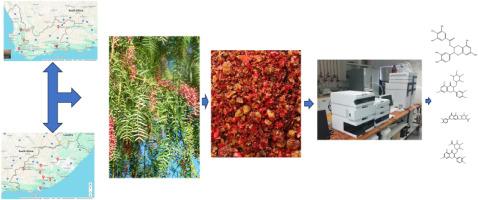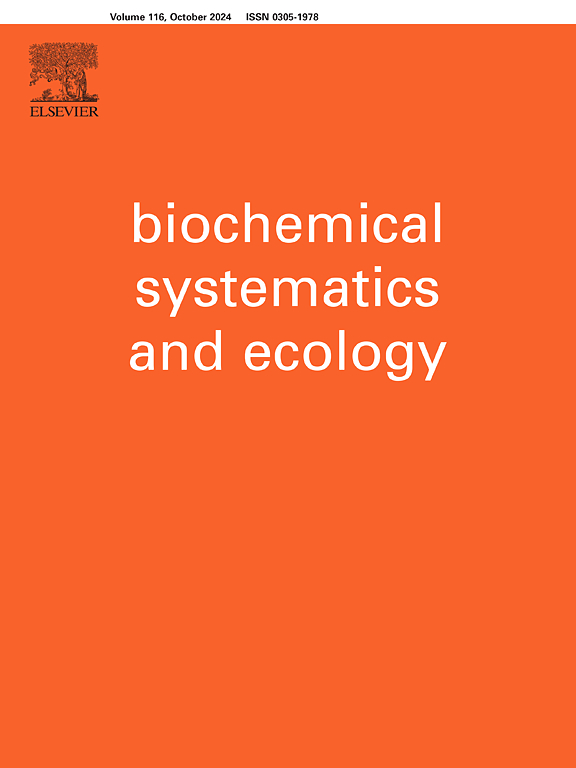南非 Schinus molle L. 花椒中基于地理位置的酚类化合物变化
IF 2
4区 生物学
Q4 BIOCHEMISTRY & MOLECULAR BIOLOGY
引用次数: 0
摘要
环境条件会影响植物中的多酚化合物,但人们对 Schinus molle 花椒对地理位置的反应却知之甚少。S molle 是一种起源于安第斯的民间假花椒,具有多种烹饪和药用功能。这种全球入侵物种具有巨大的多维潜力。因此,我们使用 UPLC-QTOF-MS 技术对生长在南非东开普省和西开普省 12 个不同地点的粉红胡椒中的多酚化合物进行了分析和定量。共报告了 11 种黄酮类化合物,包括表没食子儿茶素没食子酸酯、+)-头孢霉素 B、天竺葵素、原花青素 B5、4-苄基-7-羟基-3-苯基-2H-色烯-2-酮和异橙黄素,这在该物种中尚属首次报告。此外,还发现了五种酚酸、三种苷和鞣质(theogallin(3-galloylquinic acid)、digalloyl quinic acid、digalloylshikimic acid、β-glucogallin A 和 β-glucogallin B)等。PCA 显示,与西开普省相比,东开普省的多酚类化合物含量较高。在冬季降雨较多的沿海地区,类黄酮含量明显较高。因此,东部地区儿茶素的最高含量(1269.9 毫克/千克)比西开普省(553.4 毫克/千克)高出 229%。此外,乔治(1741 毫克/千克)和 Gqeberha(2601.2 毫克/千克)报告的异橙皮苷(isochamaejasmin)可能是含量最高的化合物,两个地区的差异达 149%。在这项研究中,土壤类型本身似乎并不完全影响多酚化合物的积累。阐明多酚类化合物在该物种中的分布可为潜在的治疗、制药和农业应用提供新的见解,包括开发新的改良有机药物和食品的可能性。本文章由计算机程序翻译,如有差异,请以英文原文为准。

Geographic based phenolic compound variations in South African Schinus molle L. peppercorns
Environmental conditions affect polyphenolic compounds in plants, and yet little is known about the response of Schinus molle peppercorns to geographical location. S molle is a folkloric pseudospice of Andean origin possessing multiple culinary and medicinal functions. This globally invasive species presents an immense multidimensional potential. Polyphenolic compounds were therefore profiled and quantified from pink peppercorns growing in 12 distinct locations in the Eastern and Western Cape provinces of South Africa using UPLC-QTOF-MS techniques. Eleven flavonoids were reported, including epigallocatechin gallate, +)-tephrorin B, astilbin, procyanidin B5, 4-benzyl-7-hydroxy-3-phenyl-2H-chromen-2-one, and isochamaejasmin which were reported for the first time in this species. Five phenolic acids, three glycosides, and tannins (theogallin (3-galloylquinic acid), digalloyl quinic acid, digalloylshikimic acid, β-glucogallin A and β-glucogallin B) were also revealed among others. PCA revealed a high composition of polyphenolic compounds in the Eastern in comparison to the Western Cape regions. Flavonoids were glaringly higher in winter rainfall receiving coastal regions. Consequently, the highest catechin content was 229% higher in the Eastern (1269.9 mg/kg) than the Western Cape (553.4 mg/kg). Furthermore, isochamaejasmin, the compound with possibly the highest concentration is reported in George (1741 mg/kg) and Gqeberha (2601.2 mg/kg) representing 149% differences between the two regions. Soil type alone did not conclusively appear to influence polyphenolic compound accumulation in this study. Elucidating the distribution of polyphenolic compounds in this species could open new insights for potential therapeutic, pharmaceutical, and agricultural applications including possibilities for new and improved organic drugs, and food product development.
求助全文
通过发布文献求助,成功后即可免费获取论文全文。
去求助
来源期刊

Biochemical Systematics and Ecology
生物-进化生物学
CiteScore
3.00
自引率
12.50%
发文量
147
审稿时长
43 days
期刊介绍:
Biochemical Systematics and Ecology is devoted to the publication of original papers and reviews, both submitted and invited, in two subject areas: I) the application of biochemistry to problems relating to systematic biology of organisms (biochemical systematics); II) the role of biochemistry in interactions between organisms or between an organism and its environment (biochemical ecology).
In the Biochemical Systematics subject area, comparative studies of the distribution of (secondary) metabolites within a wider taxon (e.g. genus or family) are welcome. Comparative studies, encompassing multiple accessions of each of the taxa within their distribution are particularly encouraged. Welcome are also studies combining classical chemosystematic studies (such as comparative HPLC-MS or GC-MS investigations) with (macro-) molecular phylogenetic studies. Studies that involve the comparative use of compounds to help differentiate among species such as adulterants or substitutes that illustrate the applied use of chemosystematics are welcome. In contrast, studies solely employing macromolecular phylogenetic techniques (gene sequences, RAPD studies etc.) will be considered out of scope. Discouraged are manuscripts that report known or new compounds from a single source taxon without addressing a systematic hypothesis. Also considered out of scope are studies using outdated and hard to reproduce macromolecular techniques such as RAPDs in combination with standard chemosystematic techniques such as GC-FID and GC-MS.
 求助内容:
求助内容: 应助结果提醒方式:
应助结果提醒方式:


